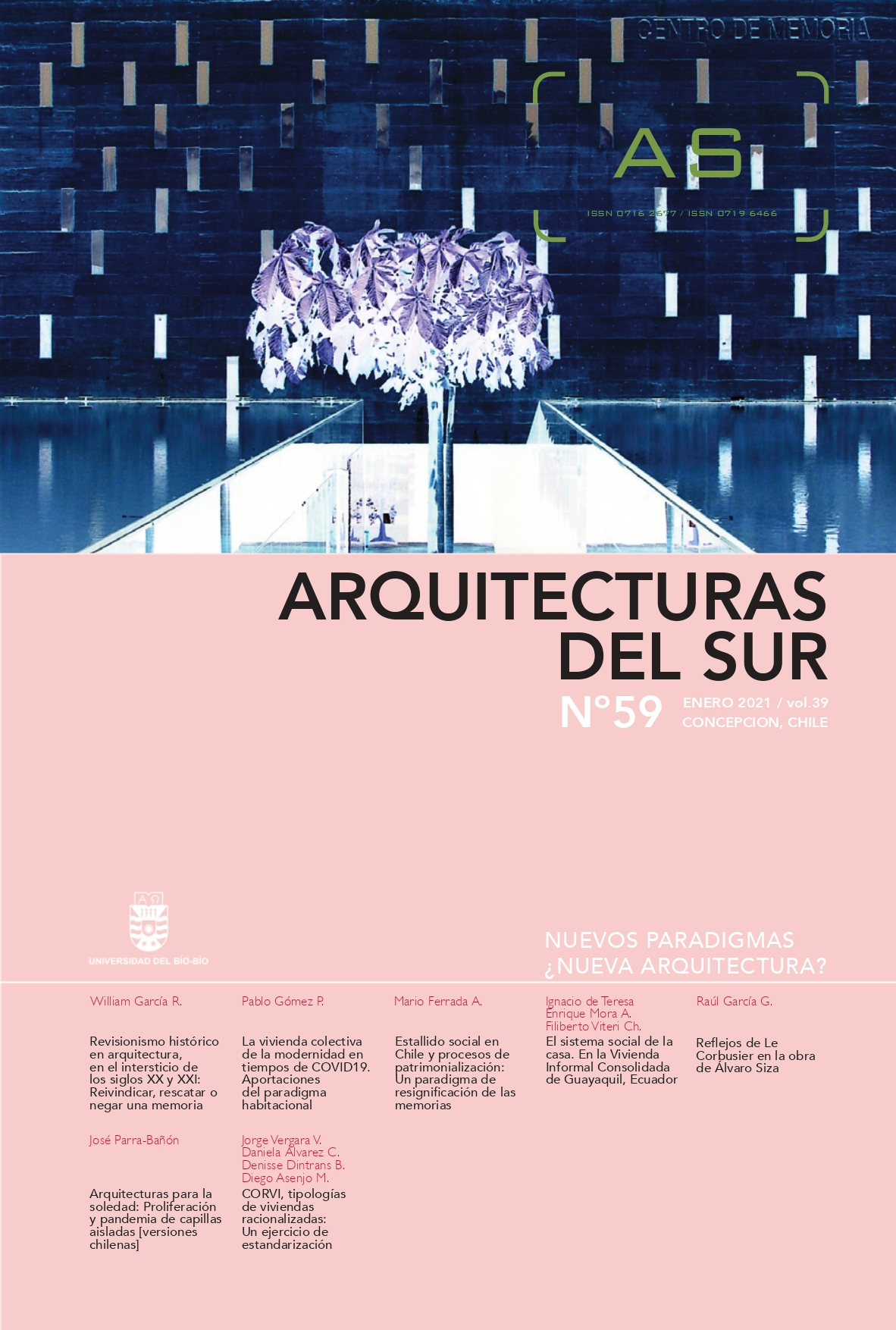Arquitecturas para la soledad. Proliferación y pandemia de capillas aisladas [versiones chilenas]
DOI:
https://doi.org/10.22320/07196466.2021.39.059.06Palabras clave:
Soledad, capilla, Eduardo Castillo, Pezo-von Ellrichshausen, Smiljan RadićResumen
“Arquitecturas para la soledad” (aquella de reducidas dimensiones que primero fue usada por un solo residente y después habitada por una mínima cantidad de personas como lugar de retiro espiritual o ámbito de ritos litúrgicos) se ocupa de analizar las circunstancias y causas del gran incremento del número de capillas aisladas que se han proyectado y construido en las dos primeras decenas del siglo XX en el orbe, y particularmente en Europa y en Latinoamérica. El estudio de tal proliferación porcentual se centra, a modo de ejemplo y de síntoma, en un reducido repertorio de obras proyectadas por arquitectos chilenos. Metodológicamente (aunque el avance que se presenta solo contenga algunos indicios de los procedimientos utilizados), el estudio se llevará a cabo revisando las páginas y portadas que les dedican las publicaciones de arquitectura, impresas o digitales, recurriendo a las estrategias discursivas de los análisis de los tipos arquitectónicos y a la semántica, a la comparación y al cálculo estadístico, a la potencialidad comunicativa de la imagen fotográfica y a la capacidad expresiva de la palabra. A partir de las tesis planteadas se propone que se redefina el término capilla para resignificarlo; de los casos presentados, que el heterogéneo repertorio formal de la contemporaneidad parte de lo vernáculo para aventurarse en la experimentación carente de prejuicios. Los datos, finalmente, permiten deducir que el auge actual de las arquitecturas eremíticas está relacionado con las circunstancias de las sociedades urbanas hegemónicas, así como pronosticar que el proceso se verá acelerado por las situaciones pandémicas venideras.
Descargas
Citas
ANDRÉS, R. (2010). No sufrir compañía. Escritos místicos sobre el silencio. Barcelona: Acantilado.
AUGÉ, M. (2000). Los no lugares. Espacios del anonimato. Barcelona: Gedisa.
CASTILLO, E. (2002). La casa del alma: capilla en El Álamo, Florida. Arquitectura Viva, (85), 52-53.
FERNÁNDEZ-GALIANO, L. (Ed.). (1998). Sagrada Forma. Arquitectura Viva, (58), 3.
FERNÁNDEZ-GALIANO, L. (Ed.). (2017a). Spaces of the Spirit. From East to West: Eight Temples. Madrid: AV (192).
FERNÁNDEZ-GALIANO, L. (Ed.). (2017b). Pezo von Ellrichshausen. Geometric Abstraction. Madrid: AV Monografías (199).
FERNÁNDEZ-GALIANO, L. (Ed.). (2019). Undurraga Devés, 2000-2019. Madrid: AV Monografías (217).
JOHNSON, P. (1979). Philip Johnson, 1906-2005. Tokyo: A + U Publishing.
LAMBERT, P. (2001). Mies in America. New York: Canadian Centre for Architecture.
MÁRQUEZ, F. (Ed.). (2019). Smiljan Radić 2013-2019. El peso del mundo. Madrid: El Croquis.
MERKEL, J. (2014). Eero Saarinen. Londres: Phaidon Press.
PARRA, J. J. (2019). Arquitectura de la melancolía. Sevilla: Athenaica.
PARRA, J. J. (Ed.). (2020). Lugares ¿Qué lugares? Venecia: Edizione Ca’ Foscari.
RADIĆ, S. (2014a). Frágil fortuna. Revista Ediciones ARQ+2, Smiljan Radić: Bestiario, 11-33.
RADIĆ, S. (2014b). La muerte en casa. Revista Ediciones ARQ+2, Smiljan Radić: Bestiario, 66-89.
ROMBERCH, J. H. (1553). Congestorium artificiose memorie. Venecia: Melchiorem Sessam.
RUDOFSKY, B. (1964). Architecture Without Architects. Nueva York: Museum of Modern Art.
SADELER, J. (1594). Sylvae Sacrae. Monumenta sanctiorus philosophie quam severa Anachoretarum.
SEVILLA, I. DE (2000). Etimologías. Madrid: BAC.
VORÁGINE, S. DE LA. (1997). La leyenda dorada. Madrid: Alianza.
ZABALBEASCOA, A. (6 junio 2018). Tour por los pabellones-capilla del Vaticano en Venecia. Del tirador a la ciudad, El País. Recuperado de https://elpais.com/elpais/2018/05/29/del_tirador_a_la_ciudad/1527616380_814098.html
Descargas
Publicado
Cómo citar
Número
Sección
Licencia
Derechos de autor 2021 José Joaquín Parra-Bañón

Esta obra está bajo una licencia internacional Creative Commons Atribución-CompartirIgual 4.0.
El contenido de los artículos que se publican en cada número de Arquitecturas del Sur, es responsabilidad exclusiva de los autores y no representan necesariamente el pensamiento, ni comprometen la opinión de la Universidad del Bío-Bío.
Las/os autoras/es conservarán sus derechos de autoría, sin embargo, garantizarán a la revista el derecho de primera publicación y difusión de su obra. La publicación del artículo en Arquitecturas del Sur está sujeta a la Licencia de Reconocimiento de Creative Commons CC BY-SA que permite a otros Adaptar: remezclar, transformar y construir sobre el material para cualquier propósito, incluso comercialmente, Compartir: copie y redistribuya el material en cualquier medio o formato, siempre y cuando se reconozcan la autoría y la primera publicación en esta revista citando correctamente, así como también sus nuevas creaciones estén bajo una licencia con los mismos términos.













 Programa de Información Científica/Concurso Fondos de Publicación de Revistas Científicas 2018/ Proyecto Mejoramiento de Visibilidad de Revistas UBB (Código:FP180007)
Programa de Información Científica/Concurso Fondos de Publicación de Revistas Científicas 2018/ Proyecto Mejoramiento de Visibilidad de Revistas UBB (Código:FP180007) 
